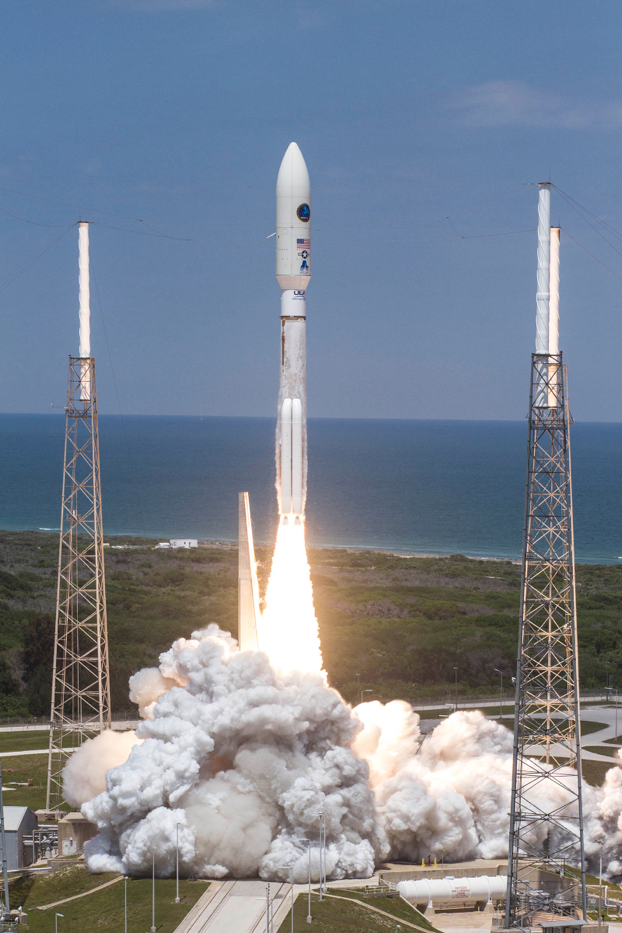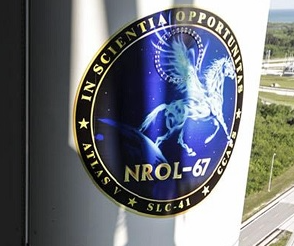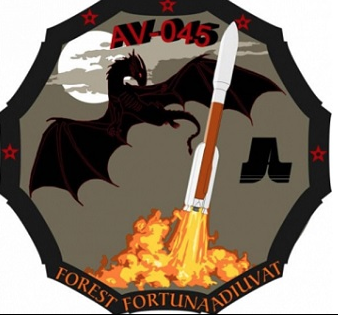[SatNews] A classified launch was successful, and created much speculation regarding the mission and the orbit...
An Atlas V rocket launched successfully from Launch Pad 41 at Cape Canaveral Air Force Station on a classified mission for the National Reconnaissance Office.

Cape Canaveral Air Force Station, Fla. (April 10, 2014) – United Launch Alliance (ULA) successfully launched the second mission in just seven days with the lift off of an Atlas V rocket carrying a payload for the National Reconnaissance Office. The mission lifted off from Space Launch Complex-41 on schedule on April 10 at 1:45 p.m. EDT. On April 3, ULA launched an Air Force weather satellite from Vandenberg Air Force Base, Calif. Photo Credit: United Launch Alliance
The rocket launch was delayed late last month after the United Launch Alliance said an issue developed with a range asset needed to support the launch.
The United Launch Alliance (ULA) have launched an Atlas V, tasked with deploying a payload for the National Reconnaissance Office. The mission, designated NRO Launch 67 (NROL-67), lifted off from Cape Canaveral’s Space Launch Complex -41 (SLC-41) on schedule at 13:45 local time (17:45 UTC) on Thursday. The National Reconnaissance Office builds and operates intelligence satellites for the U.S. government.
ULA reported no technical problems. Weather was at 90 percent favorable for the launch. Thursday’s launch took place from Space Launch Complex 41 at the Cape Canaveral Air Force Station, a former Titan launch pad which is the east coast home of the Atlas V. Constructed during the 1960s, the pad has previously been used by Titan IIIC, IIIE and Titan IV rockets.
The mission of the NROL-67 payload is classified. While this has never stopped observers identifying most NRO spacecraft ahead of their launch, this marks the first use by the NRO of an Atlas V 541 rocket, indicating that it is likely a new class of payload. As such, the spacecraft is much harder to identify as there are no similar launches to compare it to.
Notices to airmen (NOTAMS) and hazard areas published ahead of the launch show that the rocket will launch to the East, over the Atlantic Ocean, to a low-inclination orbit. Such a trajectory means that the payload is almost certainly bound for a geosynchronous orbit, since other equatorial regimes are of little value for reconnaissance.
NROL-67 was at one point also believed to be slated for a west coast launch. A launch from Vandenberg would be incapable of reaching a geosynchronous orbit.
The true nature of NROL-67 will be difficult to ascertain until the satellite has been sighted in orbit and observed over a period of several months. A team of amateur observers keep track of classified satellites, posting data on their locations and orbits online. The most likely explanation is that is a long-overdue replacement for the Mercury satellites, however this still leaves many questions unanswered.
The use of the more powerful Atlas V 541 for NROL-67 means that this payload is unlikely to be related to the Satellite Data System; however it is still possible that it could be a newer and larger satellite, two spacecraft launching together, or a satellite being placed directly into geostationary orbit rather than the transfer orbit usually used for such missions.
The Atlas V used for the NROL-67 mission was AV-045. The forty-sixth Atlas V to fly, it was the second to use the 541 configuration which made use of a payload fairing with a diameter of five meters, four solid rocket motors and a Centaur upper stage with a single engine.
This configuration has flown just once before; sending the Curiosity rover on its way to Mars in November 2011.
The first stage of the Atlas is a Common Core Booster, powered by a single RD-180 engine derived from the RD-170 series developed in the Soviet Union for the Zenit and Energia rockets.
The twin-chamber RD-180 is fueled by RP-1 propellant and liquid oxygen. Four of a maximum five Aerojet Solid Rocket Motors (SRMs) were used to augment the CCB’s thrust at liftoff on Thursday’s mission.
The second stage, the Centaur, is powered by an RL10A-4-2 engine burning liquid hydrogen and liquid oxygen. During the early stages of flight it was encapsulated, along with the payload, inside the fairing.
AV-045 sported the short variant of the five-meter fairing, measuring 20.7 meters (67.9 feet) in length and 5.4 meters (17.7 feet) in diameter.
Atlas V configurations with more than three solid rocket motors require the use of a five meter fairing, as opposed to the four meter fairing which leaves the Centaur exposed, as the upper stage would not be able to withstand the loads imparted by the additional boosters. As such, its use does not necessarily mean that NROL-67 is too large to fit within a four meter fairing like the smaller Trumpet SIGINT satellites operated in Molniya orbits.
AV-045′s flight plan was not announced. Events in the early stages were deemed to be similar to the Mars Science Laboratory launch, with RD-180 ignition occurring at T-2.7 seconds, with the solids joining them at T-0. Around eleven tenths of a second later the Atlas lifted off to begin its ascent. Roll, pitch and yaw maneuvers began at around T+5.2 seconds to attain the necessary attitude to achieve its target orbit, however the early flight was close to vertical as AV-045 climbed out of the atmosphere to reach an altitude at which fairing separation can safely occur.
The solid motors burned for around 85 to 90 seconds before they separated in pairs around 27 seconds later. Fairing separation came around the three and a half minute mark, with the forward load reactor being jettisoned from the nose of the Centaur shortly afterwards. The load reactor is a device used to dampen vibrations within the fairing while it is attached, preventing acoustic damage to the satellite.
The first stage is expected to have burned out around approximately four minutes and 20 seconds after liftoff, with the last 20 seconds of the flight being made at partial thrust as the RD-180 is throttled back to limit structural loads due to acceleration. The spent CCB is expected to have separated six seconds after cutoff, with the Centaur’s RL10 engine igniting ten seconds later.
The Centaur will make two or three burns depending on the flight profile. Assuming NROL-67 goes to geosynchronous orbit, the Atlas may place it there directly, or instead the satellite might enter a transfer orbit and raise itself to the final orbit under its own power. A typical ascent to a transfer orbit would use two burns; the first burn, which would be significantly longer than the second, would place the spacecraft into an elliptical parking orbit, with the Centaur then restarting to increase the apogee to geostationary altitude or above. On some missions an extended coast phase may be inserted between the burns to allow a higher perigee to be achieved.
Direct insertion into geostationary orbit would require a three-burn profile, while a transfer orbit could be reached in two or three burns depending on mission requirements. The three-burn profile has been favored for past NRO SIGINT launches, and is also used on some of Russia’s Proton launches. By contrast the majority of geosynchronous launches use a transfer orbit, and this approach has been used for the NRO’s Quasar satellites in the past.
Alternatively, a third burn could be made separately to raise the perigee during the coast towards apogee. A direct launch into geostationary orbit would work in much the same way, except for the third burn being made five hours after launch to circularize the orbit at apogee. In order to achieve this the Centaur must carry and extended mission kit.
For a typical mission to place a satellite directly into geostationary orbit, the Centaur would make an initial burn lasting around eight and a half minutes. After coasting for nine and a half minutes, the stage would restart and burn for about 265 seconds to reach its transfer orbit.
The Centaur would then begin rolling to maintain thermal control during its extended coast phase. After five hours and seven and a half minutes of coast, the RL10 would restart for a further two minutes to place the payload into its target orbit with spacecraft separation occurring about two and a half minutes later.
The mission patch for NROL-67 depicts the winged horse Pegasus above the Earth, with the words “in scientia opportunitas” which translate as “In knowledge there is opportunity”.

The mission patch for NROL-67 depicts the winged horse Pegasus above the Earth, with the words “in scientia opportunitas” which translate as “In knowledge there is opportunity”.

The launch patch for NROL-67 depicts a dragon set against clouds and a full moon. The motto reads “forest fortuna adiuvat”, an unusual variant spelling of “fortes fortuna adiuvat”; “fortune favours the bold”.
Significantly, the depiction of the Earth prominently shows Europe, rather than North America like most US military patches.
This may indicate where the satellite will be positioned in geostationary orbit.
The launch patch, by contrast, prominently features a dragon set against clouds and a full moon. The motto reads “forest fortuna adiuvat”, an unusual variant spelling of “fortes fortuna adiuvat”; “fortune favours the bold”. The dragon has long been a symbol associated with the NRO’s signals intelligence missions.
While it has been suggested that its presence on a patch traditionally designed by the launch team rather than the payload team may be coincidence, symbols have in the past been seen on launch patches as well as the more prominent payload patches.
NROL-67′s patches have not been circulated as widely as those from previous missions, presumably as a result of the media backlash against the patch issued for the NROL-39 mission last December.
Coming at a time of widespread contempt for US intelligence agencies, the patch – which depicted an octopus wrapping its tentacles around the world and the words “nothing is beyond our reach” —was considered to be in bad taste.
The NRO has had two or three principal constellations of spacecraft in geosynchronous orbit, each fulfilling different purposes. The Quasar or Satellite Data System (SDS) spacecraft are used to provide communications between lower-orbit reconnaissance satellites and ground stations. Three generations of SDS satellites have been launched since 1976.
The first-generation SDS constellation consisted solely of satellites in Molniya orbits; inclined elliptical trajectories which keep the satellites over high latitudes for long periods of time.
The second generation introduced a geostationary component – USA-67 was launched aboard Space Shuttle Atlantis during the STS-38 mission, along with Prowler; a one-off mission whose existence has never been officially acknowledged.
More geosynchronous satellites were introduced in the third-generation system; two spacecraft were launched to geostationary orbit at the beginning of the 2000s, with replacements launching in 2011 and 2012.
Quasar launches during the EELV era have made use of Atlas V 401 and Delta IV Medium+(4,2) rockets.
The remainder of the NRO’s geostationary fleet is used for signals intelligence (SIGINT) of one form or another. Orion satellites, formerly known as Magnum, are believed to be used to intercept and eavesdrop upon communications while the Mercury series pinpoints radar signals, although some reports reverse the assumed missions of these two series.
Another suggestion has been that the Mercury series is used to collect data from communications while Orion intercepts telemetry data from foreign missiles. The most recent mission, June 2012′s NROL-15, featured modifications to the Delta IV – already the most powerful rocket in America’s launch fleet – to increase its payload capacity.
These were rumored to be required due to the mass of the satellite. In light of this NROL-67 seems too small to be a part of this series, unless new technologies have enabled significant mass reductions over the earlier vehicles. It is not known whether the Orion satellites launched in recent years carried any modifications as a result of this program or whether it was abandoned, however there has been no sign of a new satellite taking on this combined role.
It is also possible that NROL-67 could be unrelated to the main geostationary constellations; instead it could be a one-off mission or the beginning of a completely new series.
Documents leaked to the Washington Post last year hinted at a signals intelligence satellite named “Nemesis 2″ which received half a billion dollars of funding during the 2011 financial year. No spacecraft could be identified as either Nemesis 2 or its presumed predecessor Nemesis 1. One possible, though conjectural, explanation is that Nemesis 1 may have been the Prowler satellite launched in November 1990 Shuttle Atlantis, with a follow-up being launched many years later.
One other Atlas V 541 launch for the NRO is currently scheduled; NROL-42 is scheduled to fly from Vandenberg, no earlier than the 2017 financial year.
(Images via ULA (Ben Cooper), USAF, ULA, SpaceX, L2 Historical and NASA).
JUST IN...Message From United Launch Alliance
Cape Canaveral Air Force Station, Fla ., (April 10, 2014) – A United Launch Alliance (ULA) Atlas V rocket carrying a payload for the National Reconnaissance Office (NRO) lifted off from Space Launch Complex-41 on April 10 at 1:45 p.m. EDT. Designated NROL-67, the mission is in support of national defense.
“We are honored to deliver this national security asset to orbit together with our customers the NRO Office of Space Launch and the Air Force,” said Jim Sponnick, ULA vice president, Atlas and Delta Programs. “Successfully launching two missions from two different coasts in just seven days is a testament to the team’s one-launch-at-a-time focus and ULA’s commitment to mission success and schedule reliability.”
This mission was launched aboard an Atlas V Evolved Expendable Launch Vehicle (EELV) 541 configuration vehicle, which includes a 5-meter diameter payload fairing along with four Aerojet Rocketdyne solid rocket motors attached to the Atlas booster. The Atlas booster for this mission was powered by the RD AMROSS RD-180 engine and the Centaur upper stage was powered by a single Aerojet Rocketdyne RL10A engine.
ULA's next launch is the Delta IV GPS IIF-6 mission for the United States Air Force scheduled for May 15 from Space Launch Complex-37 at Cape Canaveral Air Force Station Florida.
The EELV program was established by the United States Air Force to provide assured access to space for Department of Defense and other government payloads. The commercially developed EELV program supports the full range of government mission requirements, while delivering on schedule and providing significant cost savings over the heritage launch systems.
With more than a century of combined heritage, United Launch Alliance is the nation’s most experienced and reliable launch service provider. ULA has successfully delivered more than 80 satellites to orbit that provide critical capabilities for troops in the field, aid meteorologists in tracking severe weather, enable personal device-based GPS navigation and unlock the mysteries of our solar system. Reliable launch, real-world benefits.

